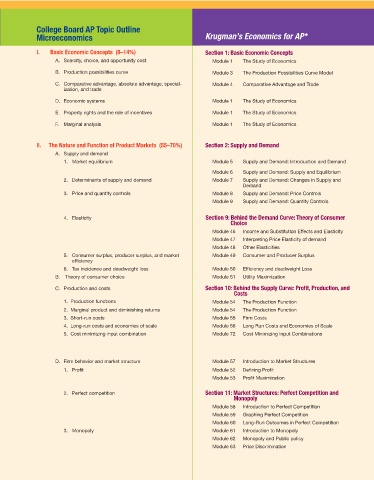Page 925 - Krugmans Economics for AP Text Book_Neat
P. 925
College Board AP Topic Outline
Microeconomics Krugman’s Economics for AP*
I. Basic Economic Concepts (8–14%) Section 1: Basic Economic Concepts
A. Scarcity, choice, and opportunity cost Module 1 The Study of Economics
B. Production possibilities curve Module 3 The Production Possibilities Curve Model
C. Comparative advantage, absolute advantage, special- Module 4 Comparative Advantage and Trade
ization, and trade
D. Economic systems Module 1 The Study of Economics
E. Property rights and the role of incentives Module 1 The Study of Economics
F. Marginal analysis Module 1 The Study of Economics
II. The Nature and Function of Product Markets (55–70%) Section 2: Supply and Demand
A. Supply and demand
1. Market equilibrium Module 5 Supply and Demand: Introduction and Demand
Module 6 Supply and Demand: Supply and Equilibrium
2. Determinants of supply and demand Module 7 Supply and Demand: Changes in Supply and
Demand
3. Price and quantity controls Module 8 Supply and Demand: Price Controls
Module 9 Supply and Demand: Quantity Controls
4. Elasticity Section 9: Behind the Demand Curve: Theory of Consumer
Choice
Module 46 Income and Substitution Effects and Elasticity
Module 47 Interpreting Price Elasticity of demand
Module 48 Other Elasticities
5. Consumer surplus, producer surplus, and market Module 49 Consumer and Producer Surplus
efficiency
6. Tax incidence and deadweight loss Module 50 Efficiency and deadweight Loss
B. Theory of consumer choice Module 51 Utility Maximization
C. Production and costs Section 10: Behind the Supply Curve: Profit, Production, and
Costs
1. Production functions Module 54 The Production Function
2. Marginal product and diminishing returns Module 54 The Production Function
3. Short-run costs Module 55 Firm Costs
4. Long-run costs and economies of scale Module 56 Long Run Costs and Economies of Scale
5. Cost minimizing input combination Module 72 Cost Minimizing Input Combinations
D. Firm behavior and market structure Module 57 Introduction to Market Structures
1. Profit Module 52 Defining Profit
Module 53 Profit Maximization
2. Perfect competition Section 11: Market Structures: Perfect Competition and
Monopoly
Module 58 Introduction to Perfect Competition
Module 59 Graphing Perfect Competition
Module 60 Long-Run Outcomes in Perfect Competition
3. Monopoly Module 61 Introduction to Monopoly
Module 62 Monopoly and Public policy
Module 63 Price Discrimination

